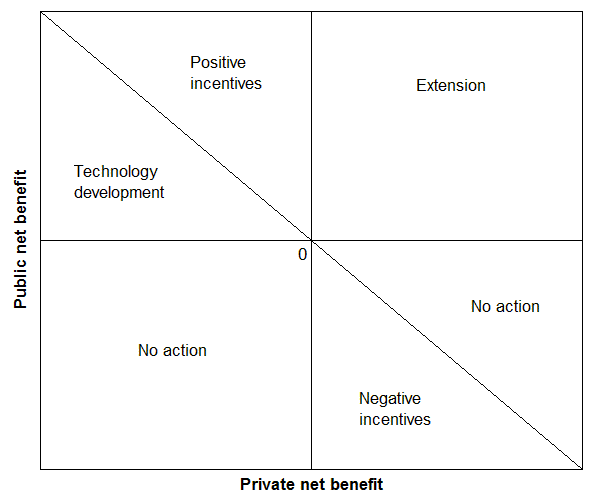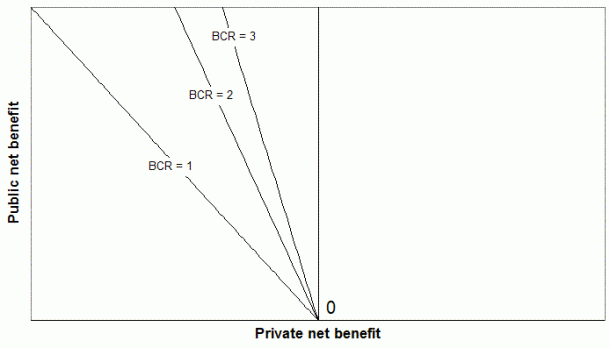74 – Public benefits, private benefits, and incentives for changing land management
This article further examines the simple framework for choosing environmental policy instruments, as outlined in PD#73. The framework is based on levels of public and private net benefits of changing land management, and a set of simple rules. We focus here on one section of main figure: that for positive incentives. With additional analysis, the framework shows that the best projects tend to be those where the net cost of the change in land-use is lowest.
In PD#73 I showed how a set of simple and reasonable rules can lead to a useful map of efficient policy instruments (Figure 1). The context is an environmental manager considering prospective projects to change land use in particular ways on particular pieces of private land. Figure 1 shows that the choice of instruments depends crucially on the levels of public and private net benefits resulting from a project. A particular project to change land use in particular ways on particular pieces of land would be represented by a dot somewhere on Figure 1. Depending on where the various dots lie, different types of policy response are recommended.
In coming Pannell Discussions I will focus more closely on particular aspects of this diagram. This time we look at the “positive incentives” triangle at top left. (It is not really a triangle, as it is open at the top, but you know what I mean.)
Figure 1. Efficient policy mechanisms for encouraging land use on private land.
“Positive incentives” means that landholders are encouraged to change their land management in particular ways (e.g. planting perennial vegetation to control the watertable or provide habitat) using tools such as subsidies, conservation auctions, or, potentially, polluter-pays mechanisms such as a pollution tax (as a penalty for not changing).
The reasons for recommending positive incentives for this area of the graph are that (a) public benefits are positive (so it might be worth somebody bearing some cost to generate them), (b) private benefits are negative (so adoption of changed practices won’t occur without some additional incentive), and (c) public benefits are large enough to outweigh the private costs (so, as a society, we can afford to pay incentives that are large enough to prompt adoption without spending more than the resulting public benefits).
How large would the created incentives have to be? They would need to be large enough to at least offset the private net cost. Let’s assume that they would exactly offset the private net costs. Given our simple assumption that the landholder would rapidly adopt change if private net benefits were positive, this seems a reasonable rule for setting the incentive. For example, if the incentive was created by paying a subsidy, to pay more than the private net cost would just provide a windfall gain to the landholder without further altering his or her behaviour, eating into the funds available for investment in environmental protection elsewhere. Our funding rule means that, for a set of projects with the same positive level of public net benefit, as we move to the right, the require incentive falls. It reaches zero where the private net benefit is zero.
The required incentive is a cost that hits either the environmental manager, if beneficiary-pays instruments are used, or the landholder, if polluter-pays instruments are used. In either case, we can divide that cost into the public benefit for every point in the triangle, and come up with a map showing all projects that generate a particular benefit:cost ratio (BCR) (Figure 2).
Figure 2. Benefit:cost ratios for projects in the “positive incentives” area.
The figure shows that benefits are greater as we move from bottom to top of the diagram (obviously!), but also as we move from left to right for a given level of public net benefit. As we approach the vertical axis, the required incentive (the cost) approaches zero, so the BCR gets bigger and bigger. The best projects in the triangle are those where private net benefits are very slightly negative (and, of course, those where the public net benefits are large). In other words, the best projects are those where the net cost of the change in land-use is lowest. It makes intuitive sense. This highlights the need for environmental managers to pay close attention to the farm-level economics of the practices they would like to see adopted.
For projects that lie on the diagonal line that bounds the region, the costs of land-use change exactly offset the gain in public benefits, so the BCR is 1.0. There is nothing to be gained by pursuing these projects, while projects further to the left have a BCR below 1.0 and a Net Present Value below zero.
In reality, the incentive required to achieve change might be greater than we have allowed for here, to get landholders over the learning hump. Also, the simple assumption about rapid adoption of all projects with positive private net benefits may not hold up. We would expect adoption to be rapid if the private net benefits were large, but otherwise, not necessarily. We will examine the consequences of these more realistic assumptions another time.
Finally, some comments on the choice between polluter-pays and beneficiary-pays instruments. The “Positive incentives” area includes both possibilities. Either could work to create an incentive for land-use change. For example, we could offer landholders a payment out of public funds (beneficiary pays in the sense that the public benefits from the environmental improvements), or we could charge them a tax for the pollution that they generate as a result of not changing land use (polluter pays). The choice depends on who is considered to have the property rights. Do farmers have the rights to farm as they wish, irrespective of any off-site costs they generate, or does the public have the right to be free of those off-site costs? The choice is essentially political (Pannell, 2004), and the politics can work in either direction. In Australia, programs like the Natural Heritage Trust and the National Action Plan for Salinity and Water Quality use beneficiary pays to influence farmers, but there are also state regulations on things like land clearing that apply polluter pays. In practice, if often seems to be the case that beneficiary pays is used to encourage landholders to change their current land management in environmentally beneficial ways, while polluter pays is used to discourage landholders from changing their current land management in environmentally damaging ways. (That is the rule of thumb we use in SIF3: Ridley and Pannell, 2005).
David Pannell, The University of Western Australia
Further Reading
Pannell, D. J. (2005) Someone has to pay … any volunteers? Voluntary versus regulatory approaches to environmental protection in agricultural landscapes of Australia. SEA Working paper 1801. CRC for Plant-based Management of Dryland Salinity, University of Western Australia. http://dpannell.fnas.uwa.edu.au/dp0406.htm
Ridley AM and Pannell DJ (2005). SIF3: An investment framework for managing dryland salinity in Australia. SEA Working paper 1901. CRC for Plant-based Management of Dryland Salinity, University of Western Australia, Perth. http://dpannell.fnas.uwa.edu.au/sif3.htm

